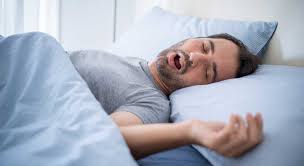Trouble breathing and sleep apnea go hand in hand, since sleep apnea is a type of breathing issue that happens during sleep. It happens when someone’s breathing is regularly interrupted while they sleep, causing broken rest and low oxygen levels in the body. Sleep apnea is a specific medical problem, but it shows how respiratory health is linked to how well you sleep in a broader sense. Understanding this link can help you better deal with both sleep problems and breathing problems that go deeper.
What does sleep apnea mean?
If you have sleep apnea, you may stop breathing several times during the night. These breaks in breathing are called apneas, and they can last from a few seconds to a minute. They can happen more than once an hour. Sleep apnea comes in three main types:
Obstructive Sleep Apnea (OSA): This is the most common type. It happens when the muscles in the throat relax too much, blocking the airway partially or completely.
This type is less common and happens when the brain doesn’t send the right information to the muscles that control breathing.
Comprehensive Sleep Apnea Syndrome is a mix of OSA and CSA. It is also called treatment-emergent central sleep apnea.
What does breathing problems have to do with sleep apnea?
Sleep apnea is all about having trouble breathing. In OSA, the airway gets blocked because of things like loose throat muscles, being overweight, or problems with the body’s structure, like a deviated septum or swollen tonsils. This makes it hard to keep a steady flow of air going while you sleep, which is what causes the breathing to stop and start.
The trouble with CSA is that the brain can’t control breathing. Instead of a physical blockage, the brain stops sending the messages that are needed to keep breathing rhythms normal every so often. This makes breathing patterns change while you sleep.
These short breaks in breathing cause:
Lower oxygen levels: apneas that happen often can lower the amount of oxygen in the blood, which puts stress on important systems like the brain and heart.
Sleep fragmentation happens when the body wakes up for a short time to start breathing normally again. This breaks sleep cycles and stops regenerative rest from happening.
Signs that you might have sleep apnea or breathing problems
Some of the signs of both sleep apnea and general breathing problems are the same.
Loud snoring (especially when you have OSA)
Having trouble breathing or choking while sleeping Being too sleepy during the day
Headaches in the morning
Having trouble focusing or remembering things
Restless sleep or waking up often at night
If you don’t treat these symptoms, they can get worse and lead to health problems like heart disease, high blood pressure, and stroke.
Things that put you at risk for sleep apnea and breathing problems
Sleep apnea and other breathing problems are more likely to happen if you have any of the following:
Being overweight: Having extra fat around the throat and mouth can make it more likely that your airway will get blocked.
Age and Gender: People in their 40s and 50s, especially guys, are more likely to get it.
Smoking and drinking alcohol can both make your airways swell and your throat muscles loosen up.
Nasal congestion: If you have allergies or nasal problems that cause chronic congestion, it can make it harder to breathe at night.
Family History: The shape of the airway and the chance of getting sleep apnea can be affected by genes.
How to Diagnose and Treat
To treat both sleep apnea and breathing problems that are causing it, it is important to get a correct evaluation. A sleep study, called polysomnography, is often used to make a diagnosis. During sleep, it measures breathing rhythms, oxygen levels, and other physiological markers.
Some treatment options are:
Lifestyle changes, like losing weight, giving up smoking, and sleeping on your side, can help ease the symptoms of OSA.
Continuous Positive Airway Pressure (CPAP) therapy is the best way to treat OSA because it keeps the airway open by circulating air continuously.
Appliances for the mouth: These move the jaw or tongue to help keep the airway open.
Surgery: In serious cases, surgery may be needed to remove blockages or fix problems with the body’s structure.
Medication: People with CSA may be given medicines like Modalert 200 Australia or equipment like adaptive servo-ventilation (ASV) to help them control their breathing.
In conclusion
There is no doubt that sleep apnea and breathing problems are linked, since sleep apnea is a disorder that causes breathing to stop or become irregular while you sleep. Understanding this link is important for correctly diagnosing and treating sleep apnea, which will improve your breathing health and general health. If you or someone you care about has signs like loud snoring, waking up often, or being too tired during the day, seeing a doctor can help you get help faster and improve your quality of life.




